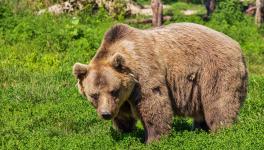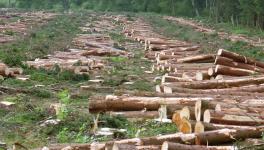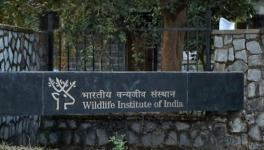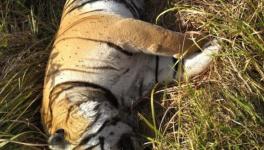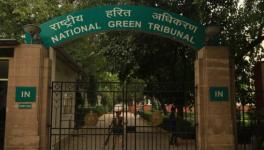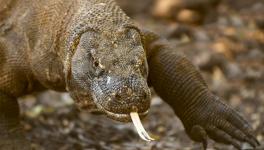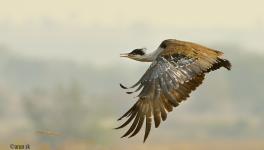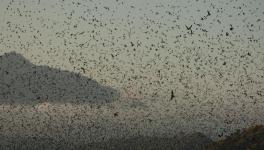India Finally Re-introduces Critically Endangered Vultures into the Wild
Image credit- Vibhu Prakash
For the first time in India, eight critically endangered white-rumped vultures were reintroduced into the wild on October 8 from the Vulture Conservation and Breeding Centre (VCBC ) in Pinjore near Chandigarh, Haryana. Aged six to eight years, six of these vultures are captive-bred and two rescued from the wild.
Vibhu Prakash, Principal Scientist and centre head at Bombay Natural History Society (BNHS), says that the release of the vultures is a milestone for the vulture conservation efforts in India. Four of the vultures were deployed with satellite transmitters and four with GSM tracker devices that work on mobile phone technology.
BNHS has plans to release the long-billed and slender-billed vultures in Madhya Pradesh and Assam respectively.
At the Pinjore centre, three of the nine species of vultures — the white-rumped, the long-billed and the slender-billed — reported from the Indian sub-continent are housed and all have bred in captivity at the Jatayu Conservation Breeding Centre, Asia’s largest breeding centre for vultures set up in 2001. After six years, the first white-rumped chick hatched in captivity at the VCBC and subsequently produced 40-50 nestlings every year.
The centre has been set up in the Bir Shikargaha Wildlife Sanctuary in Morni hills under a joint vulture conservation project of Haryana and the BNHS with funding support from the UK's Royal Society for the Protection of Birds (RSPB), The Rufford Foundation and the British government's Darwin Initiative for the Survival of Species Fund.
It took three years for the much-awaited release to actually happen. Prakash tells NewsClick, “The delay in getting permissions to obtain the satellite tags was due to the procedures involved in obtaining the license from the Department of Telecommunication under Government of India and that took one year. Further delay was because of tendering process to purchase high value equipments.”
However. the lengthy preparations continue to ensure a safe environment for the birds. “We have been making attempts to make the habitat in an area of 100 km from the centre safe for vultures by targeted advocacy and awareness programmes. The population of free ranging birds, habitats and food availability were monitored regularly as well as the prevalence of vulture toxic drugs, by carrying out undercover pharmacy surveys and cattle carcass sampling. They were evidence of good population of Gyps vultures, good food and habitat availability and low prevalence of various drugs in 100 km radius around the centre,” Prakash explains.
“We wanted to do the first release in Haryana for logistic reasons and the white-backed vulture was chosen for major distribution in this area,” Prakash says.
Giving update about the birds after release, he says that three birds have flown out of the aviary but all are near the VCBC. They are regularly fed by the centre. ‘This is what we wanted. They should stick around the centre for some time and then gradually start making forays further. This will help their survival. I also believe that the rescued wild adults will act as guide birds to captive-bred birds as they are experienced and know the tricks of survival in the wild in terms of locating food and predator avoidance,” he says.
The VCBC had released two Himalayan Griffons into the wild in 2016. Just like the current case, these vultures too stayed in the surroundings of the centre for some days and within a month they flew away. Unfortunately, the centre lost track of them after 40 days as the duo were only attached with wing tags, without satellite transmitters.
The VCBC is prepared to rescue the vultures in case any mishap or accident takes place. “If we find fixes obtained from one location for more than a day, then our team will reach the location of the bird following the coordinates from the satellite transmitters. The team would observe the bird and if there appears to be a problem, then it will be captured and brought back to the centre for treatment. We are constantly making the villagers aware about the release programme around the centre and have requested them to inform us if they see the birds with orange wing tags,” Prakash explains.
He is of the opinion that one year from now, if there is no drug-related mortality in the released birds, then around 20-25 birds will be released next year. The objective is to release 100 pairs each of the three species of vultures breeding in the centre in the coming 10 years.
The study of vultures will serve multiple purposes post their release. “The study will give insight into the movement of vultures and also the distance travelled by them in search for food in a day. It will also give information on the habitat use and ability of vultures to locate and exploit the food resources. This will also help us in evaluating the safety of environment and in preparing a management plan for vultures,” Prakash tells NewsClick.
The centre will stick to breeding the three species of vultures at the moment owing to limited resources. It has plans to include conservation breeding of the Redheaded Vulture and Egyptian Vulture in future, once sufficient numbers of birds are released into the wild from here.
The funding has posed a major challenge for the centre in implementing all its plans. “The Centre gets funding from the MoEF&CC (Ministry of Environment, Forests and Climate Change) for the last four year, but the amount and the time of release are never certain, which makes \ smooth functioning very difficult,” Prakash deplores.
Jemima Parry Jones, director at the International Centre for Birds of Prey in United Kingdom, had earlier said, “As many as 70 vultures consume a cow carcass in just half an hour which otherwise can rot infecting domestic animals, pollute water and increase the number of stray dogs. So, if these valuable species goes extinct, we will be held criminal for it.”
“California spends millions of dollars a year for vulture conservation. India should also prioritise vulture conservation because these birds are rarer than tigers and labelled critically endangered, which means there is 50% chance of their extinction in your lifetime. More than 40 million died in last two decade with just 2% left,” she further added.
Chris Bowden, program manager for RSPB says that by gauging the seriousness of the situation in India, his organisation began funding the vulture conservation program at Pinjore. He emphasised on generation of more funds as the vultures at JCBC are increasing in number.
The drug Diclofenac, which is held responsible for pushing vultures to the brink of extinction, has been banned in India since 2008. Now BNHS is trying same for the drug Aceclofenac. “BNHS is trying to do the safety testing of these drugs on vultures with the help of the Indian Veterinary Research Institute, Izzatnagar. The institute has produced evidence and requested the Drug Controller General of India to consider a ban on the veterinary use of Aceclofenac as it is a pro-drug of Diclofenac,” Prakash says.
By 2004, when around nine VCBCs began operating across the country to produce few hundreds of each of three categories of vultures specified in the country, the bird population had gone down by 99% -- close to the brink of extinction. Thanks to the conservation measures taken by VCBC, the survey carried out in 2015 revealed the existence of 6,000 white-backed vultures, 12,000 Long-billed vultures and 1,000 Slender-billed vultures in the wild, suggesting positive signs of stability in the vulture population.
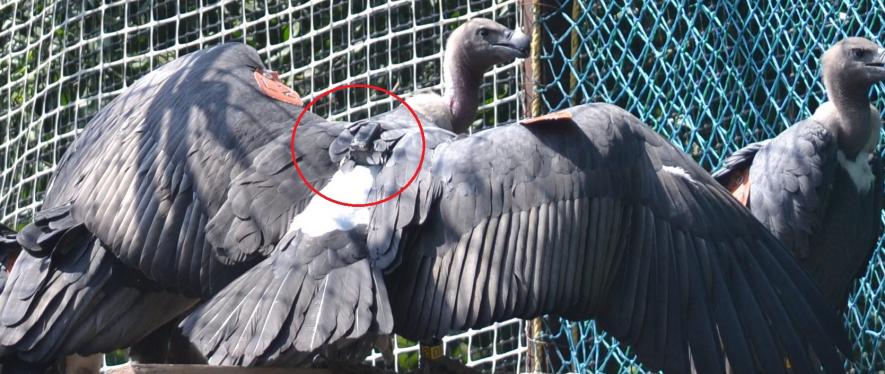
White-backed vulture with satellite transmitter
Ram Jakati, 68, former chief wildlife warden of Haryana, has been awarded with ‘Royal Society for Protection of Birds Medal for his valuable contributions in the vulture conservation at VCBC’ with which he has been associated since 2001.
“I was determined to do my best as a CWLW to save critically endangered vulture species from extinction. The situation is improving and usage of the diclofenac drug too has reduced, but we have to continue to make concerted efforts for few more decades to ensure survival of the species,” he tells NewsClick.
(Seema Sharma is an independent environment journalist based in Chandigarh.)
Get the latest reports & analysis with people's perspective on Protests, movements & deep analytical videos, discussions of the current affairs in your Telegram app. Subscribe to NewsClick's Telegram channel & get Real-Time updates on stories, as they get published on our website.










